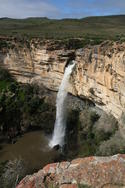Ancient Life Forms

The Richtersveld is not the place to go if you want to do some game spotting.
Big 5 country, it ain’t. And yet, despite the arid climate, there is an impressive range of smaller mammals, reptiles, insects and bird life that will appeal to people with these acquired tastes.
But before we look at the modern animals you can find, let’s take a look at the creatures that used to live here.
The fossil record demonstrates that, in wetter times, the area contained prehistoric horses, elephants, giant shrews, enormous tortoises, short-snouted crocodiles, predatory ‘bear-dogs’, large proto-ostriches and other interesting species.
These traces of ancient life forms are supplemented by fossilised footprints, burrows and impressions of trees (called dendrites) that indicate a fertile land covered with forests.
The sea was also warmer in those days, and fossilised shark teeth and unusual oyster shells have been described by various explorers (dating as far back as William Paterson in 1779).
Petrified Snapshots

In more recent times, Bushmen carved petroglyphs into the rocks of the region. These petrified ‘snapshots’ indicate that lion, giraffe, rhino, hippos and even elephant used to roam through the area.
Today, however, large animals are rare and it is the smaller lifeforms that proliferate. There is also verbal and written evidence that the plains of Namaqualand and the Richtersveld used to be heavily populated by large herds of springbok and other antelope species.
In 1892, the magistrate based at Springbokfontein (now simply called Springbok) wrote that he witnessed a migration of ‘millions’ of these graceful creatures. These flocks of game are now, sadly, a thing of the past; hastened into local extinction through hunting, livestock disease (such as the Rinderpest epidemic of 1896) and human interference with the landscape.
Nevertheless, you can still find gemsbok (oryx), klipspringer, duiker, vaalribbok and steenbok in the Richtersveld region, although these animals are more common in the restricted mining areas on the Namibian side of the border, where human activity is limited. The rare Hartmanns’ Mountain Zebra is also present.
ByDavid Fleminger